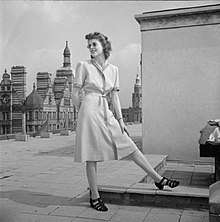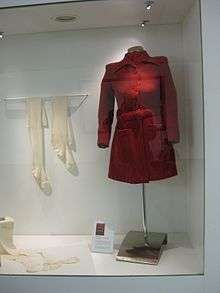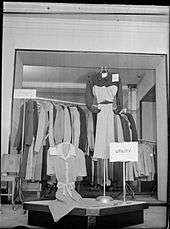Utility clothing

Utility clothing "CC41" label (Civilian Clothing 1941) applied to garments made from Utility clothes with minimum quality standards.
Utility clothing was introduced by the British government for several purposes during 1941. It was produced for economic aid during the war years. The official plan in making Utility clothing was a triumph. Garments considered as Utility clothing were labelled CC41. The double "C" resembled the Pac-Man game icon, but was seen then as an ordinary letter "C".
In this period, the government took control of supplies of raw materials for manufacturing Utility garments. During the production of Utility garments, government imposed regulations which took into consideration the economic condition of the country. Conserving raw materials such as cloth, wool, leather etc. was advisable because of limited supplies.[1] Manufacturers had their quota to produce Utility clothing which was 85% of the total production. The board of trade allowed the 15% left for the garment industry to create non-Utility clothing by meeting the style required in the regulations.[2]
The Garment industry was encouraged to produce limited stocks in order to sustain the needs of civilians and reduce the choices available to buyers and to maintain an essential quantity of garments.[3] Utility garments were liable to price control to be sold at low prices so that civilians could afford an outfit of reasonable quality.[4] Utility clothing continued into children's wear, which also had the same CC41 label.[5]
In spite of regulations and the limitation of raw materials, manufacturers and the garment industry created a variety of styles and colours of Utility clothing of satisfactory quality.[6]


The Utility Clothing Scheme was a rationing scheme introduced in the United Kingdom by the British government during World War II. In response to the shortage of clothing materials and labour due to the requirements of wartime austerity, the Board of Trade sponsored the creation of ranges of "utility clothing" meeting tight regulations regarding the amount of material and labour allowed to be used in their construction. Utility clothing, and later utility furniture, was marked with the CC41 tag.[7]
In spite of its austere specifications, utility clothing designs were commissioned from leading fashion designers including Hardy Amies, Norman Hartnell and other members of the Incorporated Society of London Fashion Designers.[8]
Government during the war years imposed the rule of using coupons for citizens to buy clothes in order to prevent the upper classes of society from having an above-minimum wardrobe and to increase the chances of the civilian being able to afford the garments.
Utility Shoes
The design of Utility shoes was chunky and solid. They had wedges or low two inch heels. Wearing open-toed shoes was prohibited as impractical and unsafe.[9]
Utility Stockings
Women used to create mock stockings by drawing lines down the back of their legs with pencil to imitate the seams of stockings because of the limited supply. Most women choose to go without stockings rather than dress in uncomfortable old rayon stockings.
Details of CC41
Examples of details of restriction orders when making Utility dress: it could have no more than two pockets, five buttons, six seams in the skirt, two inverted or box pleats or four knife pleats, and one hundred and sixty inches (four metres) of stitching. No superfluous decoration was allowed. It should be simple, practical, agreeable-looking, inexpensive and made of good material.[10]

See also
References
- ↑ Julian Robinson. (1980). Fashion in the 40’s.USA: St. Martin Press Inc.
- ↑ Hull Museums Collections. 1940s Fashion - Utility scheme. Retrieved from http://www.hullcc.gov.uk/museumcollections/collections/storydetail.php?irn=233
- ↑ Bonnie English. (2007). A cultural history of fashion in the 20th century. NY USA: Berg Oxford International Publisher Ltd.
- ↑ 1940s SOCIETY (2002 - 2017). An Introduction to Utility Clothing. Retrieved from http://www.1940.co.uk/acatalog/an-introduction-to-utility-clothing.html
- ↑ Hull Museums Collections. 1940s Fashion - Utility scheme. Retrieved from http://www.hullcc.gov.uk/museumcollections/collections/storydetail.php?irn=233
- ↑ Kristina Harris. (1996). Vintage Fashion for Women 1920’s-1940’s. Atglen : Schiffer Publishing
- ↑ "1940s Fashion - Utility scheme". Hull City Council. Retrieved 2012-01-01.
- ↑ A The National Archives (2010, February 18). Fashion or ration: Harnell, Amies and dressing for the Blitz. Retrieved from http://media.nationalarchives.gov.uk/index.php/fashion-or-ration-hartnell-amies-and-dressing-for-the-blitz/
- ↑ Hull Museums Collections. 1940s Fashion - Utility scheme. Retrieved from http://www.hullcc.gov.uk/museumcollections/collections/storydetail.php?irn=233
- ↑ Wade Laboissionniere. (1997). Blue Prints of Fashion: home-sewing patterns of the twentieth century, 1940’s. Atglen : Schiffer Publishing Ltd